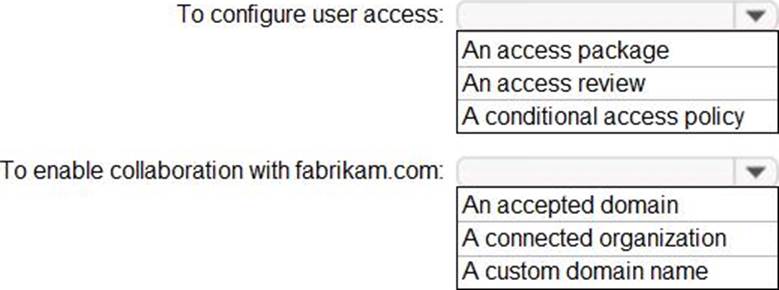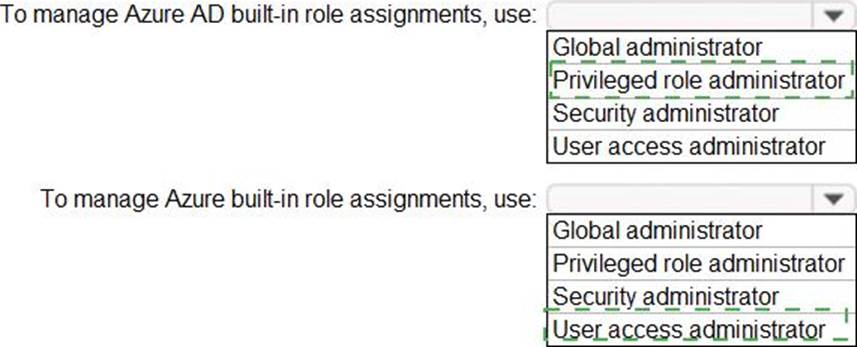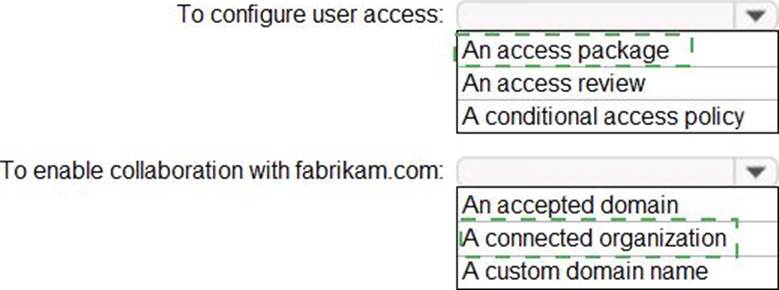Microsoft SC-300 Real Exam Questions
The questions for SC-300 were last updated at Dec 22,2025.
- Exam Code: SC-300
- Exam Name: Microsoft Identity and Access Administrator
- Certification Provider: Microsoft
- Latest update: Dec 22,2025
You need to resolve the issue of the guest user invitations.
What should you do for the Azure AD tenant?
- A . Configure the Continuous access evaluation settings.
- B . Modify the External collaboration settings.
- C . Configure the Access reviews settings.
- D . Configure a Conditional Access policy.
HOTSPOT
You need to identify which roles to use for managing role assignments. The solution must meet the delegation requirements.
What should you do? To answer, select the appropriate options in the answer area. NOTE: Each correct selection is worth one point.

You have an Azure Active Directory (Azure AD) tenant that contains a user named SecAdmin1. SecAdmin1 is assigned the Security administrator role.
SecAdmin1 reports that she cannot reset passwords from the Azure AD Identity Protection portal.
You need to ensure that SecAdmin1 can manage passwords and invalidate sessions on behalf of nonadministrative users. The solution must use the principle of least privilege.
Which role should you assign to SecAdmin1?
- A . Authentication administrator
- B . Helpdesk administrator
- C . Privileged authentication administrator
- D . Security operator
You have an Azure Active Directory (Azure AD) tenant.
For the tenant. Users can register applications Is set to No.
A user named Admin1 must deploy a new cloud app named App1.
You need to ensure that Admin1 can register App1 in Azure AD. The solution must use the principle of least privilege.
Which role should you assign to Admin1?
- A . Application developer in Azure AD
- B . App Configuration Data Owner for Subscription1
- C . Managed Application Contributor for Subscription1
- D . Cloud application administrator in Azure AD
You configure a new Microsoft 36S tenant to use a default domain name of contosso.com.
You need to ensure that you can control access to Microsoft 365 resource-, by using conditional access policy.
What should you do first?
- A . Disable the User consent settings.
- B . Disable Security defaults.
- C . Configure a multi-factor authentication (Ml A) registration policy1.
- D . Configure password protection for Windows Server Active Directory.
HOTSPOT
You need to implement the planned changes and technical requirements for the marketing department.
What should you do? To answer, select the appropriate options in the answer area. NOTE: Each correct selection is worth one point.

Topic 1, Litware, Inc
Overview
Litware, Inc. is a pharmaceutical company that has a subsidiary named fabrikam, inc Litware has offices in Boston and Seattle, but has employees located across the United States. Employees connect remotely to either office by using a VPN connection.
Identity Environment
The network contains an Active Directory forest named litware.com that is linked to an Azure Active Directory (Azure AD) tenant named litware.com. Azure AD Connect uses pass-through authentication and has password hash synchronization disabled. Litware.com contains a user named User1 who oversees all application development.
Litware implements Azure AD Application Proxy.
Fabrikam has an Azure AD tenant named fabrikam.com. The users at Fabrikam access the resources in litware.com by using guest accounts in the litware.com tenant.
Cloud Environment
All the users at Litware have Microsoft 365 Enterprise E5 licenses. All the built-in anomaly detection polices in Microsoft Cloud App Security are enabled.
Litware has an Azure subscription associated to the litware.com Azure AD tenant. The subscription contains an Azure Sentinel instance that uses the Azure Active Directory connector and the Office 365 connector. Azure Sentinel currently collects the Azure AD sign-ins logs and audit logs.
On-premises Environment
The on-premises network contains the severs shown in the following table.

Both Litware offices connect directly to the internet. Both offices connect to virtual networks in the Azure subscription by using a site-to-site VPN connection. All on-premises domain controllers are prevented from accessing the internet.
Delegation Requirements
Litware identifies the following delegation requirements:
* Delegate the management of privileged roles by using Azure AD Privileged Identity Management (PIM).
* Prevent nonprivileged users from registering applications in the litware.com Azure AD tenant-
* Use custom catalogs and custom programs for Identity Governance.
* Ensure that User1 can create enterprise applications in Azure AD. Use the principle of least privilege.
Licensing Requirements
Litware recently added a custom user attribute named LWLicenses to the litware.com Active Directory forest. Litware wants to manage the assignment of Azure AD licenses by
modifying the value of the LWLicenses attribute. Users who have the appropriate value for LWLicenses must be added automatically to Microsoft 365 group that he appropriate license assigned.
Management Requirement
Litware wants to create a group named LWGroup1 will contain all the Azure AD user accounts for Litware but exclude all the Azure AD guest accounts.
Authentication Requirements
Litware identifies the following authentication requirements:
• Implement multi-factor authentication (MFA) for all Litware users.
• Exempt users from using MFA to authenticate to Azure AD from the Boston office of Litware.
• Implement a banned password list for the litware.com forest.
• Enforce MFA when accessing on-premises applications.
• Automatically detect and remediate externally leaked credentials
Access Requirements
Litware wants to create a group named LWGroup1 that will contain all the Azure AD user accounts for Litware but exclude all the Azure AD guest accounts.
Monitoring Requirements
Litware wants to use the Fusion rule in Azure Sentinel to detect multi-staged that include a combination of suspicious Azure AD sign-ins followed by anomalous Microsoft Office 365 activity.
You need to meet the authentication requirements for leaked credentials.
What should you do?
- A . Enable federation with PingFederate in Azure AD Connect.
- B . Configure Azure AD Password Protection.
- C . Enable password hash synchronization in Azure AD Connect.
- D . Configure an authentication method policy in Azure AD.
You use Azure Monitor to analyze Azure Active Directory (Azure AD) activity logs.
Yon receive more than 100 email alerts each day for tailed Azure Al) user sign-in attempts.
You need to ensure that a new security administrator receives the alerts instead of you.
Solution: From Azure monitor, you modify the action group.
Does this meet the goal?
- A . Yes
- B . No
You have an Azure Active Directory (Azure AD) tenant that contains the following objects:
✑ A device named Device1
✑ Users named User1, User2, User3, User4, and User5
✑ Groups named Group1, Group2, Group3, Group4, and Group5
The groups are configured as shown in the following table.

To which groups can you assign a Microsoft Office 365 Enterprise E5 license directly?
- A . Group1 and Group4 only
- B . Group1, Group2, Group3, Group4, and Group5
- C . Group1 and Group2 only
- D . Group1 only
- E . Group1, Group2, Group4, and Group5 only
HOTSPOT
You need to implement password restrictions to meet the authentication requirements.
You install the Azure AD password Protection DC agent on DC1.
What should you do next? To answer, select the appropriate options in the answer area. NOTE: Each correct selection is worth one point.




